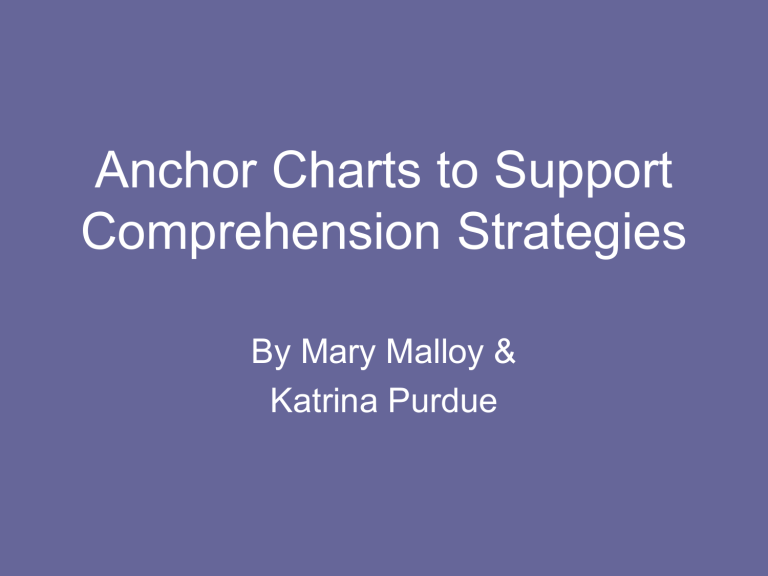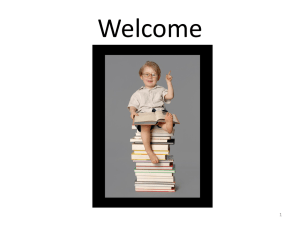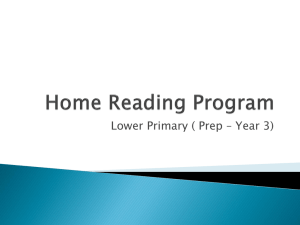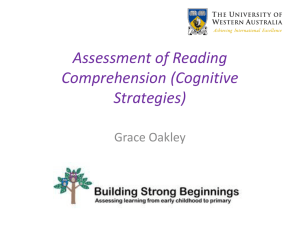Anchor Charts to Support Comprehension Strategies
advertisement

Anchor Charts to Support Comprehension Strategies By Mary Malloy & Katrina Purdue Professional Development IRT training from Cindy and Therese Embedded Midvale PD • Year 1- Primary Literacy Notebook • Year 2- Comprehension Strategies with Debbie Miller • Year 3- Comprehension revisited + writing Resources • Literacy Room Books • Book Room Titles for Book Club Curriculum Maps DRAFT MONTH September October November December January February March April May FIRST GRADE LITERACY CURRICULUM MAP WRITING* COMPREHENSION STRATEGIES** Writing Sample Literary Elements Book 1: Launching the Writing (Little Yellow Chicken) Workshop (Corduroy) Book 2: Small Moments: Making Connections: Personal Narrative Writing T-S, T-T, T-W (Chrysanthemum) Book 3: Writing for Readers: Predicting Teaching Skills and Strategies Book 4: The Craft of Revision Inferring Assessing Book 5: Authors as Mentors Review/Assess PLAA Comprehension Strategies: Book 7: Poetry Creating Mental Images Book 6: Nonfiction Writing Asking Questions Book 6 - continued Determining Importance/ Non Fiction Reviewing and Assessing PLAA Comprehension Strategies Teacher or Student Choice Assessing *Refers to Units of Study for Primary Writing by Lucy Calkins **Order of comprehension strategy instruction is based on Mosaic of Thought, Second Edition by Keene and Zimmermann, page 34 . Genres are presented throughout the year. Once the strategies are introduced they are reinforced throughout the year. DRAFT MONTH September October November December January February March April May SECOND GRADE LITERACY CURRICULUM MAP WRITING* COMPREHENSION STRATEGIES** Writing Sample Literary Elements/Retelling Book 1: Launching the Writing (The Man, the boy and the Workshop Donkey) Book 2: Small Moments: Making Connections: Personal Narrative Writing T-S, T-T, T-W (A Quilt for Kristi) Book 3: Writing for Readers: Predicting/Inferring Teaching Skills and Strategies Book 4: The Craft of Revision Questioning Assessing Book 5: Authors as Mentors Review/Assess PLAA Comprehension Strategies: Book 7: Poetry Creating Mental Images Book 6: Nonfiction Writing Determining Importance Book 6 - continued Synthesizing Teacher or Student Choice Assessing Reviewing and Assessing PLAA Comprehension Strategies *Refers to Units of Study for Primary Writing by Lucy Calkins **Order of comprehension strategy instruction is based on Mosaic of Thought, Second Edition by Keene and Zimmermann, page 34 . Genres are presented throughout the year. Once the strategies are introduced they are reinforced throughout the year. Implementation • Modeling (Anchor Charts) • Shared Practice (Anchor Charts) • Guided Practice (notebooks) • Independent Practice (Book Club, notebooks) Monitoring Comprehension Connections Book Club • • • • Heterogeneous Small Groups Adult reads book aloud to group Each child is given a copy of the text Students reflect and use post-its to track their thinking • Students initiate discussions • Follow-up reflection in reading journals Book Club Introduction Book Club Book Club • First Session • Second Session Inferring Questioning Book Club Mental Imaging Mental Imaging Texts Book Club Revisited Determining Importance Determining Importance Determining Importance with Fables Book Club • magazines • poetry Synthesizing Synthesizing Synthesizing with Allen Say Synthesizing Summary of Book Club • • • • • Evolved over the year Added to format (coding, one main idea) Changed genres (poetry and nonfiction) Developed oral language Students problem solved around group dynamics Volunteers and students became more comfortable with format Thanks to the 2nd graders who deepened our thinking!







